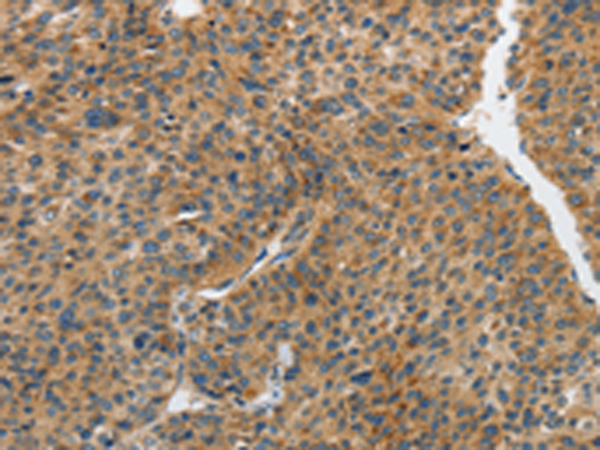


| WB | 咨询技术 | Human,Mouse,Rat |
| IF | 咨询技术 | Human,Mouse,Rat |
| IHC | 1/25-1/100 | Human,Mouse,Rat |
| ICC | 技术咨询 | Human,Mouse,Rat |
| FCM | 咨询技术 | Human,Mouse,Rat |
| Elisa | 1/2000-1/5000 | Human,Mouse,Rat |
| Aliases | LCCS3; PIPKIg_v4; PIP5Kgamma; PIP5K-GAMMA |
| WB Predicted band size | 73 kDa |
| Host/Isotype | Rabbit IgG |
| Antibody Type | Primary antibody |
| Storage | Store at 4°C short term. Aliquot and store at -20°C long term. Avoid freeze/thaw cycles. |
| Species Reactivity | Human, Mouse, Rat |
| Immunogen | Synthetic peptide of human PIP5K1C |
| Formulation | Purified antibody in PBS with 0.05% sodium azide and 50% glycerol. |
+ +
以下是3-4篇关于 **PIP5K1C抗体** 的参考文献及其摘要概括:
---
1. **"PIP5K1C regulates tau pathology and neurodegeneration in Alzheimer’s disease"**
*Authors: Wang et al. (2022)*
摘要:研究通过使用PIP5K1C特异性抗体,发现该激酶通过调控磷脂酰肌醇代谢影响Tau蛋白异常磷酸化,并证实其在阿尔茨海默病模型小鼠中促进神经退行性变。
2. **"Phosphatidylinositol-4-phosphate 5-kinase 1c associates with focal adhesions and regulates cancer cell metastasis"**
*Authors: Sun et al. (2020)*
摘要:利用PIP5K1C抗体进行免疫荧光和Western blot分析,揭示其在癌细胞黏着斑中的定位,并证明其通过调节细胞骨架动态驱动肿瘤转移。
3. **"PIP5K1C controls synaptic vesicle exocytosis through phosphoinositide signaling"**
*Authors: Di Paolo et al. (2019)*
摘要:通过抗体阻断实验,发现PIP5K1C生成的PI(4.5)P₂脂质对突触囊泡释放至关重要,并阐明其在神经元分泌中的分子机制。
4. **"A monoclonal antibody targeting PIP5K1C inhibits enzymatic activity and suppresses tumor growth"**
*Authors: Chen et al. (2021)*
摘要:开发了一种靶向PIP5K1C的单克隆抗体,证实其可特异性抑制激酶活性,并在体内实验中显著减缓多种癌症模型的肿瘤进展。
---
以上文献均聚焦于PIP5K1C的功能研究,涉及抗体在疾病模型、分子机制及治疗中的应用。如需具体DOI或期刊信息可进一步补充。
The PIP5K1C antibody is a crucial tool for studying the phosphatidylinositol-4-phosphate 5-kinase type 1 gamma (PIP5K1C), an enzyme encoded by the *PIP5K1C* gene. PIP5K1C belongs to the phosphatidylinositol-4-phosphate 5-kinase family, which catalyzes the phosphorylation of phosphatidylinositol-4-phosphate (PI4P) to generate phosphatidylinositol-4.5-bisphosphate (PIP2). PIP2 is a key lipid secondary messenger regulating membrane dynamics, cytoskeletal organization, and cellular signaling pathways such as receptor trafficking, ion channel modulation, and endocytosis. PIP5K1C is particularly noted for its role in neuronal development, synaptic vesicle recycling, and cancer cell migration.
The antibody is widely used in techniques like Western blotting (WB), immunohistochemistry (IHC), and immunofluorescence (IF) to detect PIP5K1C expression, localization, and post-translational modifications in tissues or cell lines. Researchers employ it to explore PIP5K1C's involvement in diseases, including neurodegenerative disorders (e.g., Alzheimer’s), cancer metastasis, and immune dysfunction. Its specificity is often validated via knockout controls or siRNA-mediated knockdown.
Due to alternative splicing, PIP5K1C has multiple isoforms (e.g., PIP5K1C-90 and PIP5K1C-87), and some antibodies may distinguish between these variants. Understanding PIP5K1C's regulatory mechanisms through such antibodies provides insights into therapeutic targeting of PIP2-mediated pathways in disease contexts.
×